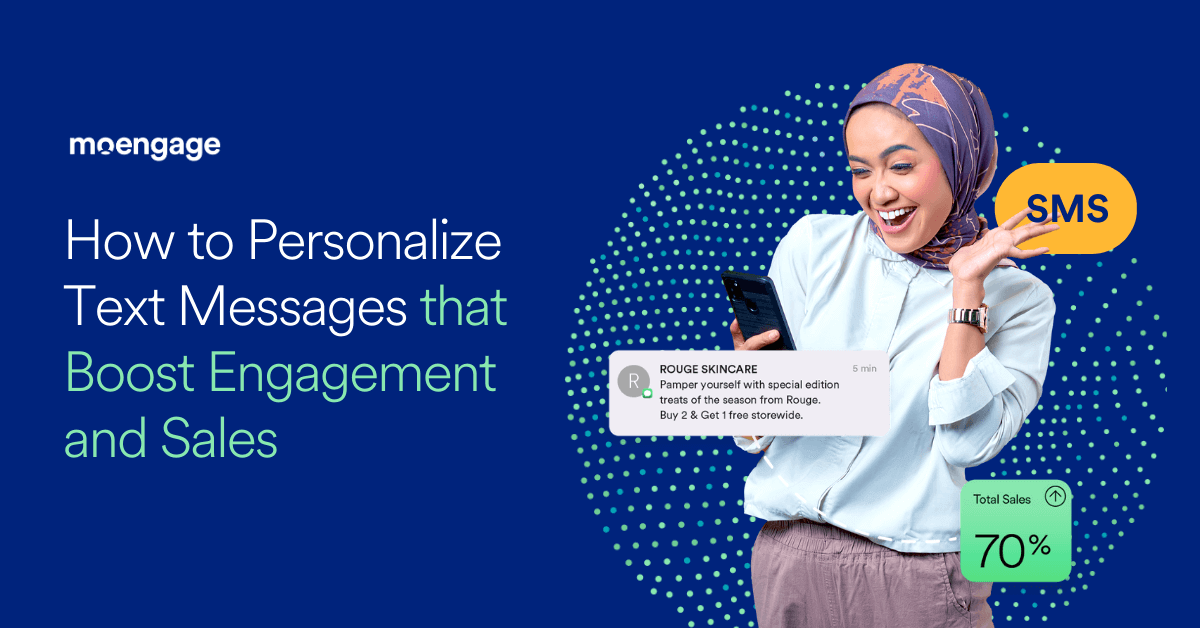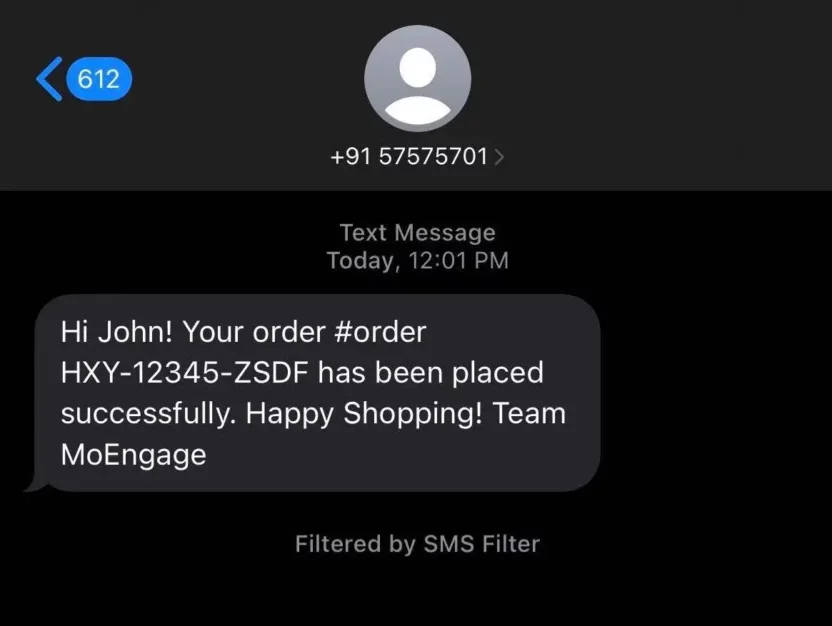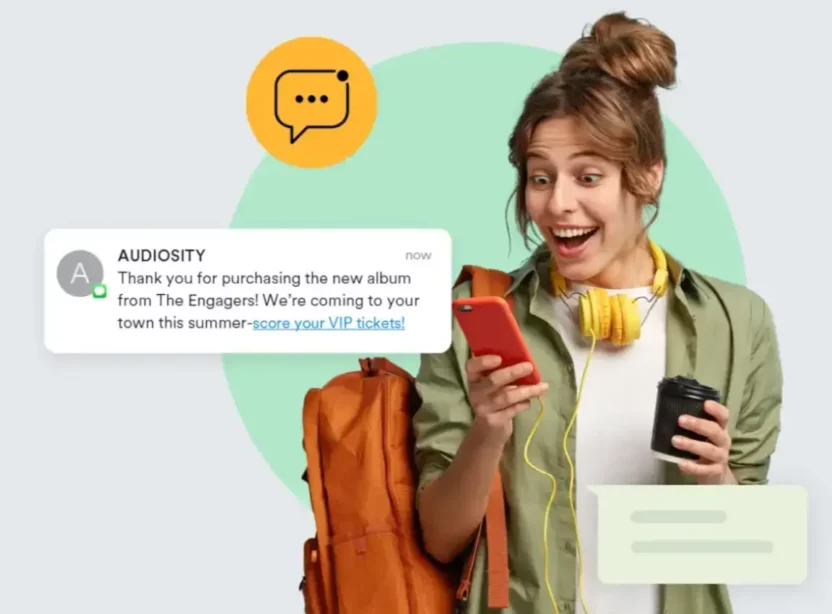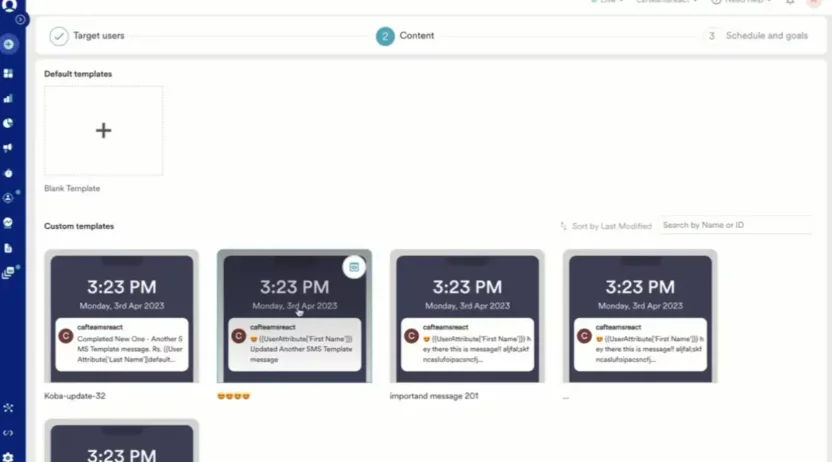6 Best Practices to Personalize Text Messages for Better Conversions

Reading Time: 7 minutes
There are many ways to reach and engage customers in this digital age; email marketing, social media, display advertising, and pay-per-click. However, with inboxes overflowing and ad blockers becoming more commonplace, businesses are turning to Short Message Service (SMS), aka texting, to create promotional and transactional messages that address customers instantly.
In this article, we’ll share insights on how your business can use text message marketing.
| Upgrade your omnichannel experience with integrated SMS marketing with MoEngage. |
Why Are Personalized Text Messages Important for Your Brand?
A text tailored to its recipient will have better engagement and conversion. Why? Because mobile phones are a direct channel that customers pay attention to throughout the day, and when you send a text message that is timely, easy to digest, and relevant to the recipient, it is difficult for them to ignore it.
A study by Retail Dive stated that SMS receives eight times the response rate of email, and according to Brooke Burdge, a former SVP of brand marketing at Attentive, more than half of the consumers who sign up to receive texts from brands are interested in engaging via text two to three times per week.
This proves that SMS is among the most effective ways to reach and interact with prospects or customers.
It also helps that text messages are instant, received on mobile, and don’t require the internet. Messages will likely be read faster because they are short and easy to engage with.
Personalizing your text messages will help them perform better and stand out while establishing a stronger connection with your audience.
If you are considering investing more resources in text message marketing, these are some rewards you stand to gain.
- Boosts revenue: People love buying but don’t like being sold to. Informal, personalized texts feel less salesy, so consumers are at ease when they get offers via SMS. Also, because they get an alert whenever a new text message arrives, they tend to act on an offer as soon as it is received.
Reaching an already engaged audience in real-time through a channel that gets their immediate attention could be the perfect reminder they need to make or complete a purchase.
- Increases brand loyalty: Messaging your customers on a platform they use to talk freely with friends can make them warm up to you more quickly, especially if they already like your brand and opted to receive text messages from you.
If you consistently send valuable text messages, focus on their preferences and respect their boundaries, customers will likely appreciate your brand more and stick with you long-term. You’ll also find that this will encourage them to actively participate by responding to your texts, sharing feedback, and interacting with quizzes or surveys.
- Deepens connection with customers and your network: Personalized texts can improve customer experience and help you connect personally. It allows customers and future connections to interact with your brand quickly and shows that you know them.
It also accommodates different segments of your network, such as elderly consumers or those who aren’t tech-savvy and don’t frequently use email or generic social media. Your audience will always feel like you’re speaking to them directly and that they can reach out to you anytime. You can then use this opportunity to send urgent notifications like transactional messages, hold their attention, answer their questions, share updates, and offer sweet deals.
- Contributes to customer retention: As customer acquisition cost consistently rises, SMS can nurture your network and customer relationships, offer post-purchase support, and keep your brand at the top of their mind.
Through text messaging, you can create an easily accessible channel for customers to communicate with customer service personnel, offer quick feedback, and resolve their issues promptly.
- Offers higher conversion rates: Text message marketing offers easy access, fewer barriers, and timely updates about new products, services, or deals. Texts are straight to the point, and recipients immediately know what action to take.
Texts are guaranteed to be seen compared to marketing emails that get lost in the promotions tab. According to Gartner, personalized text messages are also highly engaging for marketing, with open rates of 98%. It offers a much higher ROI than other channels, such as paid social or display advertising, and has been mentioned as one of the most effective ways to reach customers and drive new sales.
How do you Personalize Text Messages for Better Conversions?
Personalizing text messages involves tailoring the content of your message to the specific recipient, using their name or other information that is relevant to them.
For example, a personalized text message to a customer on their birthday could look like this;
| “Hi, Sarah! Today is all about you. Celebrate by treating yourself with this special HBD 10% discount code. Shop now [CTA link].” |
Including the customer’s name in your text is a good way to personalize your message. It makes the recipient feel important and like you know them.

In addition to mentioning the recipient’s name, there are other elements you can use to personalize text messages depending on the purpose or context of your message. To remind customers about a monthly subscription, you can personalize your message by including the product name and shipping date. For example;
| “Hey Marcus, sending you a friendly reminder that your monthly subscription for [product name] will be shipped on [date]. Track this order here [CTA link]” |
Ideally, customers should feel like your brand is a friend texting them. Personalization in marketing matters because it allows you to create the most relevant content possible for each customer, and often on a fairly automated basis.
SMS is already a personal and informal communication channel. Using the customer’s name, mentioning products they bought, and including other relevant details collected from customer data will help deepen the relationship and make them more likely to engage with your messages.
Here are three distinctive ways to personalize your text messages and connect with customers.
- Include personal information such as names, pronouns, birthdays, locations, and other personal details.
- Reference relevant events like a past purchase, an abandoned cart, or the next delivery date for a subscription service to personalize your text message for each recipient further.
- Share content that aligns with the recipient’s interests or preferences. You can pull data from previous communication or purchase history to hyper-personalize your message. Many businesses achieve this by combining real-time buyer intent data with artificial intelligence (AI) and marketing automation.
While following these tips, ensure your text is conversational and concise. Use a friendly tone and stick to 160 characters or less. Also, create a documented content plan for SMS, which will go a long way in boosting engagement and conversions.
6 Best Practices to Improve Text Messaging Conversions
Text message marketing is effective but sensitive. It works best when you want to send timely info about promotions, updates, and reminders, but you risk losing subscribers if your text messages become too frequent and intrusive.
To find balance and formulate the right strategy for content, frequency, and delivery, here are six best practices to guide you;
1. Incentivize customers to subscribe to your SMS list
SMS is a permission-based marketing channel. This means you need consumers to consent or opt-in to receiving text messages–as the law requires. They’ll also need to give you their phone number and respond positively to your confirmation message before they are added to your list.
Good opt-in incentives for customers include offering discounts, promoting exclusive sales, or simply letting them know the perks they’ll receive when they subscribe. Be specific in your opt-in forms and when you mention benefits, e.g., state if it’s “25% off” and how long the code is valid. Also, let them know how often you’ll be sending texts and your messages’ content.
2. Segment lists for better targeting
No one wants to feel like they’re just a random number you text, so tailoring your messages to each recipient is essential.

You can collect subscriber data from your CRM database and link custom fields in your SMS software to help segment your list. Many businesses typically create a group of loyal customers, but it’s beyond that. You should segment customers based on behavioral data to enable you to deliver exclusive offers aligned with their interests, past purchases, or previous interactions with your brand. In addition, you can group customers based on geographic locations so that your text messages are sent at appropriate times.
3. Incorporate relevant personalization data.
With your customer’s personal, behavioral, and geographical data at your fingertips, you can easily personalize text messages. As you send promo codes, remind consumers about appointments, or confirm purchases, add specific customer data relevant to the text and write in the lingo of your different customer segments.
4. Use SMS templates

Templates exist for different SMS categories, such as welcome messages, seasonal promotions, cart abandonment, and new product launches. They include placeholders that you can personalize with your customer data.
Here’s an example of an SMS template for a new product launch;
| Hi [name]! We’re launching [new product name] on [date]. Sign up to be the first to try it. Join the waitlist [CTA link] |
Alternatively, here’s a template for a welcome message;
| Thanks for subscribing to [name]! Here’s your coupon for [X% off]. Shop and Auto-Apply the discount here [CTA link] |
A template for an order confirmation message could also look different from the examples above because it references data besides the customer name. Here’s an example;
| Your order for [product name] on [date] from [store name] has been received. To track your parcel, visit [tracking link]. |
If you get stuck when composing a text message, templates will help you get past writer’s block. It’s also helpful to use an AI writer to rephrase the sentences from each template (to ensure there are no duplicates) until you’re satisfied.
5. Use text message marketing software.
A big part of personalization is automation. If you send texts to only a handful of customers, you can manually swap placeholders in your message templates for basic customer information. However, sending bulk requires an SMS marketing platform to automate the process using the recipients’ data to generate personalized messages and deliver text at scale.
6. Pay attention to the details.
Your text message should include essential elements such as a good value offer, a strong CTA, and a link to access the offer. Invite recipients to respond and ensure customer reps are equipped to reply quickly. Keep your tone conversational, stick to 160 characters or less, and include emojis, gifs, or quizzes in a fun casual way.
Attention to all these details will differentiate you from other spammy brands and help boost your SMS engagements. If you’re ever in doubt, look at other businesses with great SMS campaigns. Read case studies that break down their strategies and find tactics you can adopt.
Engage Customers with Interactive, Personalized Text Messages
Sending text messages with personalized content helps create a more engaging and interactive experience for customers. However, your SMS marketing strategy shouldn’t be executed in isolation. Leverage our no-code, insights-led customer engagement platform to integrate SMS seamlessly with your other marketing channels. Track links in your SMS messages, analyze your SMS performance, and grow your audience using custom sign-up prompts.







